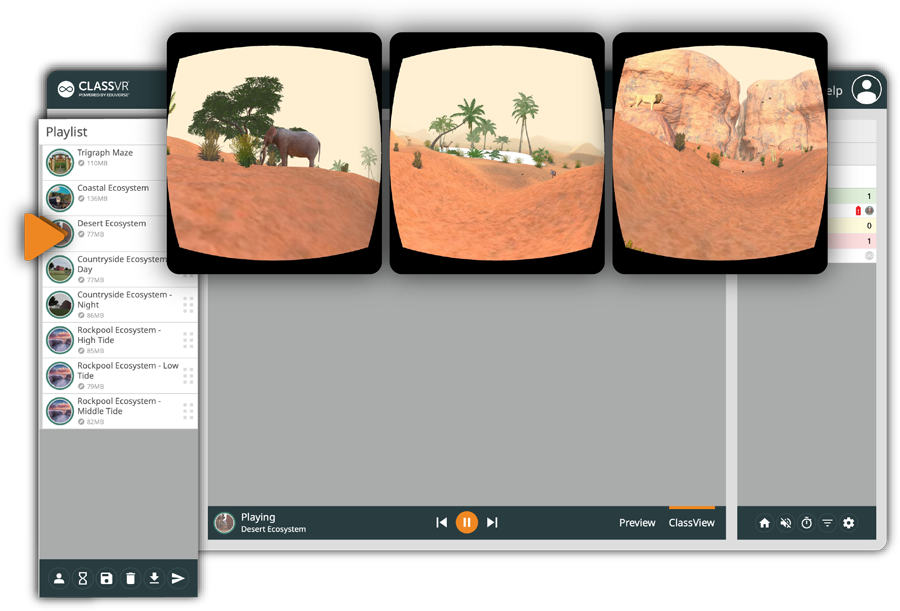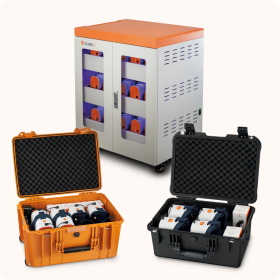How ClassVR Works
Create and deliver immersive, engaging lessons with ClassVR’s classroom-ready VR and AR solution. Built specifically for education, ClassVR brings together powerful hardware, curriculum-aligned content, and intuitive device management in one easy-to-use platform, giving teachers the flexibility to enrich learning across every subject and grade level.
Since its launch in 2017, ClassVR has been adopted in over 200,000 classrooms, 40,000 schools, and 90+ countries worldwide. The core benefit of virtual reality in education is simple, students learn better when they can see, feel, and experience concepts instead of just reading about them. By turning lessons into unforgettable experiences, ClassVR makes learning more engaging, interactive, and effective for every student.
In this blog, we’ll explore:
- What’s included in the ClassVR solution
- How ClassVR works in the classroom
- The benefits of using ClassVR
What’s Included in the ClassVR Solution
When schools adopt ClassVR, they receive a complete, ready-to-use solution. Each part of the solution works together to make VR and AR simple and effective for classrooms.
%20(160%20x%2090%20px).png?updatedAt=1757327274348)
The Hardware: ClassVR Headsets
ClassVR headsets provide a safe, secure, and comfortable way for students to explore VR and AR. With adjustable head straps, intuitive controls, and a student-friendly interface, the devices are designed for learners of all ages. Teachers maintain full control over every device to ensure safe and focused learning experiences.

The Content: Curriculum-Aligned VR & AR Resources
ClassVR includes thousands of curriculum-aligned VR and AR resources, lesson plans, guides, and worksheets designed to boost engagement across grade levels and subjects. Teachers can also upload their own content, access resources shared by other ClassVR educators, or integrate third-party VR/AR educational content.

The Software: ClassVR Teacher Portal
ClassVR headsets provide a safe, secure, and comfortable way for students to explore VR and AR. With adjustable head straps, intuitive controls, and a student-friendly interface, the devices are designed for learners of all ages. Teachers maintain full control over every device to ensure safe and focused learning experiences.
.png)
Product Training
To help teachers get started, ClassVR includes an online professional development course with bite-sized lessons and quizzes. In addition, Educational Specialists, who are all qualified teachers, are available to provide training and support on how to make the most of VR in the classroom.

Storage and Charging
Headsets are stored safely in a custom designed case with a durable ABS shell and protective foam interior. Available in sets of 4, 8 or 30, each case includes built-in charging that works even when the lid is closed, ensuring devices are always ready for the next lesson.
How Does ClassVR Work in the Classroom?
ClassVR makes it easy for teachers to bring immersive learning into everyday lessons. Setup is simple, and content can be delivered to student headsets in just a few clicks through the Teacher Portal
Teachers can seamlessly integrate ClassVR into their lesson planning by building custom playlists of experiences, saving them for future use, and aligning them with learning goals. During the lesson, teachers use ClassView to monitor each device in real time, ensuring students stay engaged and on task.
Whether guiding a whole class through an ancient civilisation, focusing attention on a science experiment, or giving students independent exploration time, ClassVR puts teachers in control while opening doors to new learning possibilities.
What Are the Benefits of ClassVR?
Virtual reality empowers students to learn through experience. With ClassVR, learners can travel the world, explore complex concepts, or develop soft skills, all from the safety of the classroom.
The benefits of VR in the classroom are significant. Students can increase knowledge retention and memory power, stay more engaged and excited during lessons, and improve learning outcomes, especially when tackling complex or difficult subjects. VR also helps focus student attention, while making learning more accessible and inclusive for diverse learners.